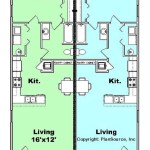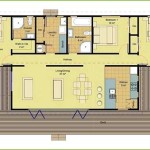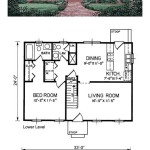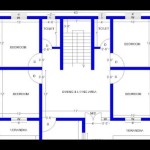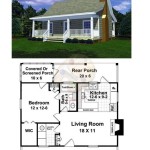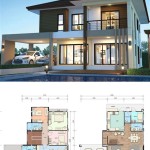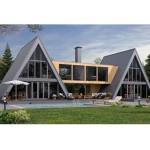Simple One Bedroom Floor Plan With Dimensions In Meters
A well-designed one-bedroom floor plan can maximize space, functionality, and comfort, even within a compact footprint. Understanding dimensions in meters is crucial for planning furniture placement, assessing accessibility, and visualizing the overall flow of the living space. This article explores key considerations for creating a simple one-bedroom floor plan, focusing on dimensions and spatial efficiency.
The fundamental components of a one-bedroom apartment typically include a bedroom, a bathroom, a living area, and a kitchen. Variations might involve the addition of a dining area, a balcony or patio, and walk-in closets. The overall size of the apartment dictates the possibilities for each room. A smaller apartment necessitates clever storage solutions and multi-functional furniture, while a larger apartment offers more flexibility in layout and design.
Before delving into specific dimensions, it's important to consider the orientation of the apartment. Natural light is a significant factor in the livability of any space. Southern exposure often provides the most consistent sunlight throughout the day, while eastern exposure offers morning light and western exposure brings in afternoon sun. Northern exposure, conversely, tends to be the least sunny. The placement of windows and doors should be strategically planned to maximize natural light and ventilation within the apartment.
Building codes and regulations often dictate minimum room sizes. These minimums vary depending on the location and are intended to ensure adequate living space and safety. Before finalizing any floor plan, it is crucial to consult local building codes to ensure compliance. These codes may specify minimum ceiling heights, window sizes, and egress requirements.
Accessibility is another critical consideration. Universal design principles advocate for creating spaces that are usable by people of all abilities. This may involve wider doorways, accessible bathroom fixtures, and clear pathways throughout the apartment.
Key Considerations for Room Dimensions
Each room in a one-bedroom apartment requires careful planning to ensure it meets the needs of the occupant. Below are some general dimension guidelines in meters for each area, keeping in mind that these are suggestions and can be adjusted based on the overall apartment size and individual preferences.
Bedroom: The bedroom is arguably the most important space within the apartment. It should be a peaceful and comfortable retreat. A minimum dimension of 3 meters by 3 meters (9 square meters) is generally considered adequate for a basic bedroom with a double bed. However, a more comfortable size would be closer to 3.5 meters by 4 meters (14 square meters), allowing for additional furniture such as a bedside table, a dresser, and potentially a small seating area. The placement of the bed is crucial. It should be positioned to maximize natural light and avoid being directly in line with the doorway.
Bathroom: Bathroom dimensions are often dictated by the required fixtures: a toilet, a sink, and a shower or bathtub. A compact bathroom can be as small as 1.5 meters by 2 meters (3 square meters), but this can feel cramped. A more comfortable size would be closer to 2 meters by 2.5 meters (5 square meters). The layout should ensure adequate space around each fixture for comfortable use. The placement of the toilet should adhere to local plumbing codes and allow for proper ventilation.
Living Area: The living area serves as the primary space for relaxation, entertainment, and socializing. The size of the living area will depend on the overall apartment size and the intended use of the space. A minimum size of 3.5 meters by 4 meters (14 square meters) is generally sufficient for a basic living area with a sofa, a coffee table, and a television. A larger living area, such as 4 meters by 5 meters (20 square meters), offers more flexibility in furniture arrangement and allows for the inclusion of a dining area or a workspace. Adequate space should be left for pathways and circulation.
Kitchen: Kitchen layouts can vary significantly depending on the apartment style and size. The most common layouts are galley kitchens, L-shaped kitchens, and U-shaped kitchens. A galley kitchen, ideal for smaller apartments, typically requires a width of at least 1.8 meters to allow for comfortable movement. An L-shaped kitchen, which offers more counter space and storage, typically requires a minimum floor area of 6 square meters. A U-shaped kitchen, the most spacious layout, offers ample counter space and storage but requires a larger floor area of at least 8 square meters. The placement of appliances, such as the refrigerator, stove, and sink, should be carefully considered to create an efficient workflow.
Walk-in Closet/Storage: While not always present in a small one-bedroom, a walk-in closet is a desirable feature. A minimum size for a functional walk-in closet is around 1.5 meters by 2 meters. This provides enough space to store clothes and shoes, with room to move around. If space is limited, a reach-in closet with a depth of at least 60 centimeters can provide adequate storage.
Optimizing Space in a Small One-Bedroom Apartment
When dealing with a smaller one-bedroom apartment, maximizing space is paramount. Employing clever design strategies and multi-functional furniture can significantly enhance the livability of the space.
Multi-functional Furniture: Furniture that serves multiple purposes is essential for small spaces. Sofa beds provide seating during the day and a sleeping space at night. Storage ottomans offer seating and storage. Drop-leaf tables can be used as dining tables or desks and folded away when not in use. Investing in furniture designed specifically for small spaces can make a significant difference.
Vertical Storage: Utilizing vertical space is crucial for maximizing storage in a small apartment. Tall bookshelves, wall-mounted shelves, and overhead cabinets can provide ample storage without taking up valuable floor space. Consider installing shelves above doorways or in narrow hallways to utilize otherwise wasted space.
Mirrors: Mirrors can create the illusion of more space by reflecting light and visually expanding the room. A large mirror placed on a wall can make a small room feel significantly larger. Mirrors can also be used to brighten up dark corners and create a more inviting atmosphere.
Open Floor Plan: An open floor plan, where the living area and kitchen are combined into a single space, can create a sense of spaciousness. Removing walls between rooms allows for better flow and natural light. However, it's important to define different zones within the open space using furniture arrangement or rugs to create distinct areas for living, dining, and cooking.
Color Palette: Choosing a light and airy color palette can make a small apartment feel more spacious and inviting. Light colors reflect light, making the room feel brighter and larger. Avoid dark colors, which can absorb light and make the room feel smaller. Accent colors can be used to add visual interest and personality to the space.
Decluttering: Regularly decluttering and removing unnecessary items is essential for maintaining a sense of order and spaciousness in a small apartment. Get rid of items that are not used or loved. Organize belongings and store them in designated areas. A clutter-free environment can significantly improve the overall livability of the space.
Understanding Dimensions and Building Codes
Accurate measurements and compliance with building codes are essential aspects of any floor plan. Incorrect dimensions can lead to construction errors and code violations, resulting in costly delays and potential safety hazards.
Accurate Measurements: Precise measurements are crucial for planning furniture placement, calculating material quantities, and ensuring that the floor plan meets code requirements. Use a reliable measuring tape or laser measuring device to obtain accurate dimensions. Double-check measurements to avoid errors.
Building Codes and Regulations: Building codes and regulations vary depending on the location and are intended to ensure the safety and well-being of occupants. These codes may specify minimum room sizes, ceiling heights, window sizes, and egress requirements. Consult local building codes before finalizing any floor plan to ensure compliance.
Egress Requirements: Egress refers to the ability to exit a building safely in the event of an emergency. Building codes typically require that each room have at least one means of egress, such as a door or a window that meets specific size requirements. Ensure that all rooms in the one-bedroom apartment meet egress requirements.
Accessibility Codes: Accessibility codes, such as the Americans with Disabilities Act (ADA), mandate that buildings be accessible to people with disabilities. These codes may specify requirements for doorway widths, bathroom fixtures, and clear pathways. Incorporate universal design principles into the floor plan to create a space that is usable by people of all abilities.
In conclusion, creating a simple one-bedroom floor plan with optimal dimensions involves a careful consideration of factors such as room sizes, natural light, storage requirements, and building codes. By prioritizing functionality, efficiency, and accessibility, it's possible to design a comfortable and livable space, regardless of square footage. Furthermore, understanding dimension in meters allows one to accurately assess and plan for furniture placement and spatial utilization.

Simple Basic 1 Bedroom House Plans Under 1200 Sq Ft

Affordable One Bedroom Design For 7 X 6 Meters Lot Ulric Home

Small House Plans 5x6 M Hip Roof One Bedroom Design F0

Log Plan 960 Square Feet 1 Bedroom Bathroom Floor 035 00244 America S Best House Plans

12 Examples Of Floor Plans With Dimensions

One Bedroom House Plans 21x21 Feet 6 5x6 5m Tiny

Small House Plans 6x6 With One Bedroom Hip Roof 286
20x20 Tiny House Cabin Plan 1 Bedrm Bath 400 Sq Ft 126 1022

Single Story House Plans

Rommell One Y Modern With Roof Deck Pinoy Eplans
Related Posts

